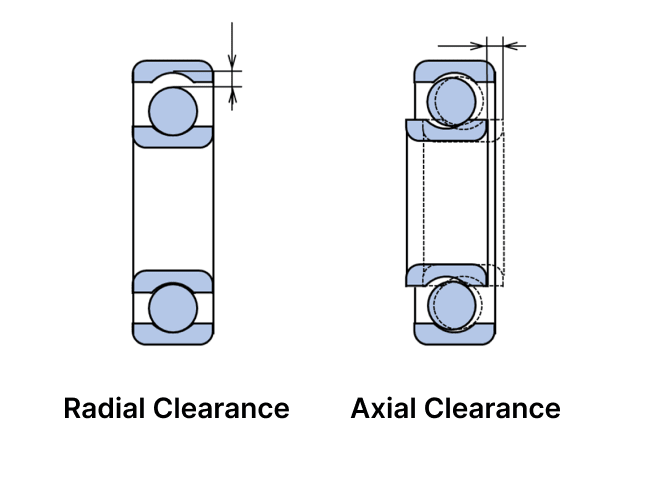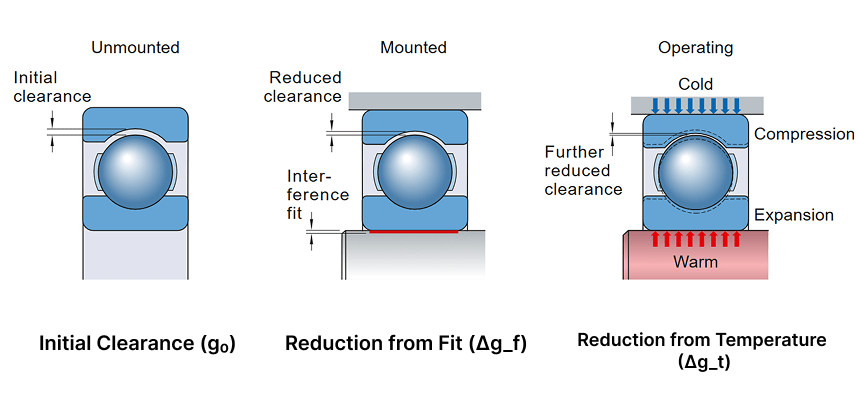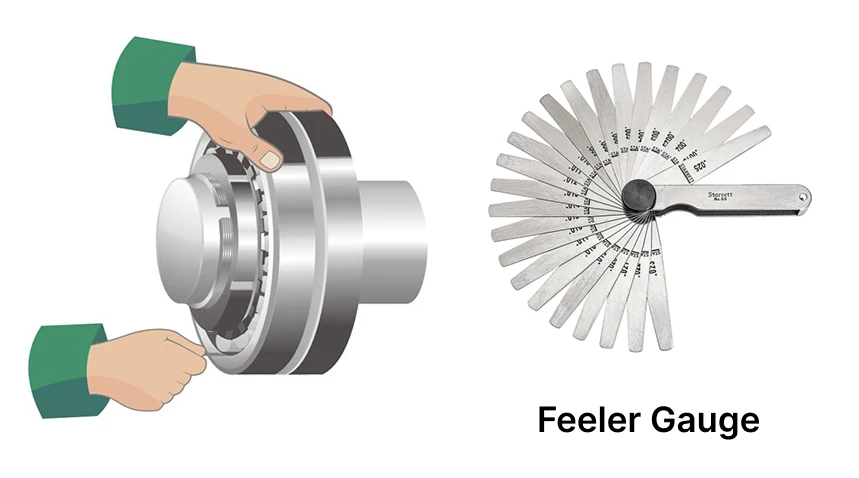Knowledge Center
A Bearing’s “Breathing Room”: Understanding Clearance from Initial to Operating
Have you ever wondered if the inside of a high-precision bearing is perfectly tight? In reality, there is a tiny but critical amount of “room to move” between the rolling elements and the raceways. We call this “Clearance.” The size of this space directly impacts the bearing’s life, noise, temperature, and performance.
Today, let’s explore this invisible “breathing room” and learn how to make sure it’s just right when your equipment is running.
Section Navigation
#1 Precision, Clearance and Preload
#2 Bearing Failure Analysis Atlas
#3 Cost & Efficiency Optimization & Reliability Upgrade
What Is Clearance and Why Is It Important?
Bearing clearance is the total distance that one ring can move relative to the other, either in the radial direction (up and down) or the axial direction (side to side), when the other ring is fixed.
- Simple Analogy: When you wear clothes, you wouldn’t choose a sweater that’s so tight you can’t breathe, nor a jacket so loose it falls off. You need something that fits well but still gives you room to move. A bearing’s clearance is like the “fit” of its clothes.
Radial vs. Axial Clearance: Two Directions of Movement
When we talk about clearance, it exists in two main directions:
- Radial Clearance: This is the “up-and-down” movement. Imagine the inner ring moving up and down inside the outer ring (perpendicular to the shaft’s axis). This is the most common type of clearance we discuss and measure. When we see codes like C3 or C4, they refer to the radial clearance.
- Axial Clearance: This is the “side-to-side” or “end-to-end” movement. Imagine the inner ring sliding back and forth along the axis inside the outer ring.
For many bearings, like deep groove ball bearings, these two clearances are related. A certain amount of radial clearance will naturally result in a specific amount of axial clearance. However, when we select and measure bearings, we almost always use the radial clearance as the standard.
Why is clearance so critical?
Because a bearing’s clearance changes when it goes from “in the box” to “running in a machine”! This happens for two main reasons:
- Installation Fit: To prevent the inner ring from slipping on the shaft, we often use an “interference fit.” This slightly stretches the inner ring, which reduces the clearance.
- Operating Temperature: When a bearing runs, it gets hot. The inner ring and rolling elements usually become hotter than the outer ring. This causes them to expand more, further reducing the clearance.
Consequences of Incorrect Clearance:
- Clearance too small (or negative/preload): Like wearing a tight sweater, this creates high internal pressure. It leads to a sharp increase in friction and heat, causing the bearing to fail very quickly.
- Clearance too large: Like wearing a baggy jacket, this allows the rolling elements to hit the raceway with impact and vibration. It results in noisy operation, lower running accuracy, and poor load distribution, which shortens the bearing’s life.
Factory Settings – Clearance Classes for Non-Adjustable Bearings
For most common bearings like deep groove ball bearings and cylindrical roller bearings, their initial clearance is set at the factory and cannot be adjusted. Our job is to select the correct clearance class based on the operating conditions.
Here are the most common clearance classes and their typical applications:
| Class | Name | Clearance Size | Typical Applications |
| C2 | C2 Class | Smaller than Normal | For high-precision, low-noise applications with very little heat, like in precision instruments or the non-drive end of machine tool spindles. |
| CN (or C0) | Normal Class | Standard Clearance | The general standard for light or medium loads with little heat and standard fits. |
| C3 | C3 Class | Larger than Normal | The most widely used class! Perfect for standard electric motors, pumps, and automotive applications with normal operating temperatures and interference fits. |
| C4 | C4 Class | Larger than C3 | For applications with higher temperatures, high speeds, or tight interference fits, like in motorcycle engines or vibrating screens. |
| C5 | C5 Class | Larger than C4 | For high-temperature environments, such as in steel rolling mills or paper machinery. |
Pro Tip: When in doubt, choosing C3 clearance is often safer than choosing CN, because it provides more “breathing room” for heat expansion and installation fits.
From Initial to Operating – Calculating the Change in Clearance
Our ultimate goal is to have the Operating Clearance be a small, positive value when the bearing is running at a stable temperature. To achieve this, we start with the Initial Clearance and subtract the factors that reduce it.
A simplified formula is:
Operating Clearance (gₑ) = Initial Clearance (g₀) – Reduction from Fit (Δg_f) – Reduction from Temperature (Δg_t)
- Initial Clearance (g₀): This is the clearance of the bearing you buy (e.g., C3). It is a range of values that you can find in the bearing manufacturer’s catalog.
- Reduction from Fit (Δg_f): The interference fit between the inner ring and the shaft causes the inner ring raceway to expand, which reduces the clearance. This value can be calculated with engineering formulas based on the fit and bearing dimensions.
- Reduction from Temperature (Δg_t): The temperature difference between the inner and outer rings causes the inner ring to expand more, which also reduces the clearance. This value is calculated based on the temperature difference, bearing size, and material expansion properties.
In practice, these complex calculations are usually done by design engineers. As a user, it’s more important to understand this process. This helps you see why a larger initial clearance, like C4 or C5, is necessary for high-temperature or tight-fit applications.
How to Measure Clearance – Professional Tools
Before installation or during failure analysis, we may need to measure the initial radial clearance of a bearing. The most common tool for this is a Feeler Gauge.
Measurement Steps:
- Place the bearing horizontally on a flat surface and fix the outer ring.
- Push the inner ring and rolling elements down to their lowest point.
- At the very top of the bearing (the 12 o’clock position), try to insert feeler gauge blades of different thicknesses between a rolling element and the outer raceway.
- Find the thickest blade that fits smoothly into the gap. Its thickness is the measured radial clearance.
For more precise measurements, engineers also use a Dial Indicator with a special fixture to get more accurate readings.
Giving Your Bearing the Right Amount of “Breathing Room”
Bearing clearance is a dynamic parameter that changes. Choosing the correct initial clearance is an act of “prediction”—predicting how much it will be reduced after installation and during operation to ensure the final operating clearance is in the optimal range. By understanding how clearance changes, you can more scientifically select and maintain bearings for your equipment and avoid premature failures caused by a fit that is “too tight” or “too loose.”
Not finding what you need?
If you have enquiries about our product or solutionservice, please contact us via email.


